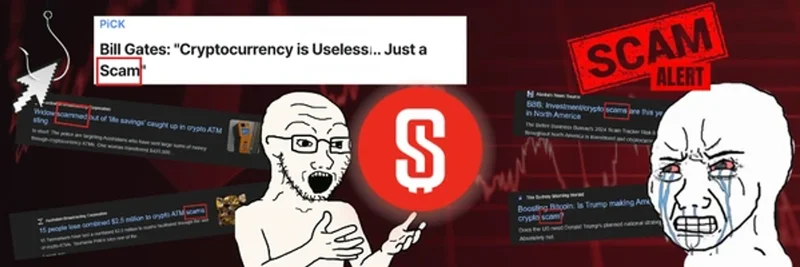If you've ever scrolled through Solana meme coins, you might have stumbled across one with a name that’s almost too on-the-nose: SCAM. Here’s what you need to know about this tongue-in-cheek token, what it says about the state of Solana’s meme ecosystem, and—most importantly—how to approach such projects safely.
What is SCAM (Solana Retardz/Scamcoin)?
The SCAM token (Solscan) is a meme-based cryptocurrency created on the Solana blockchain. Unlike most tokens that try to convince you of their legitimacy, SCAM fully embraces the idea that “crypto is a scam”—right down to its name. It’s part satire, part social commentary, and all about the wild west culture that dominates Solana’s meme coin market.
- Token Symbol: $SCAM
- Token Address: 9mNjA6BizTwpvd4DS3o7BjwZ6aPM9DC2jLHS7JFGbonk
- Launched on: Likely Pump.fun, Solana’s meme coin launchpad
- Market Cap: Fluctuates from ~$7,500 to ~$465,000 (micro-cap, very volatile)
- Circulating Supply: Roughly 1 billion tokens
- Community Narrative: “The first token where the dev got rugged, and the community took over”
Why Call It SCAM?
The name isn’t just for laughs—it’s a satirical jab at the reality that Solana’s meme coin scene is riddled with scams, rug pulls, and pump-and-dumps. DEX analytics platforms like Raydium, GeckoTerminal, and Solana Tracker reflect active trading but also show extreme price volatility and significant wallet concentration.
A statement on DEX Screener pretty much sums up the token’s ironic spirit: “Dev abandoned project and is a scam LOL. Do not buy this it is a SCAM!” That kind of raw, self-aware humor is what draws many degens into the mix—but don’t let that blind you to the risks.
Solana Meme Coin Landscape: Opportunity Meets Risk
Solana is beloved for its low fees and lightning-fast speed (up to 50,000 TPS), which has helped spawn a frenzy of meme coins. But this same openness has made it a hotbed for scams. Some industry sources estimate that 98–99% of tokens launched on platforms like Pump.fun or in Raydium liquidity pools show classic scam characteristics: sudden rug pulls, devs vanishing with funds, or even tokens that let the creator burn coins right out of your wallet (via “Permanent Delegate” exploits).
Here are common scam tactics seen on Solana:
- Airdrop scams: Random tokens sent to your wallet that lead you to phishing sites
- Rug pulls: Devs hype a project then abandon it or drain liquidity
- Permanent Delegate exploits: Token contracts that allow creators to burn or move your tokens
- Address poisoning: Scammers use similar addresses to trick you into sending them funds
How Risky is SCAM? Let’s Dig In.
While the community claims to have taken over after a dev rug pull, there's little verifiable evidence for this narrative. SCAM is clear about its lack of utility (“no utility, no roadmap, no hope”) and thrives on memes and social buzz. As of July 2025, a few key numbers stand out:
- Top 10 holders own nearly 20% of supply
- Snipers own 15%, insiders 13.6%, team wallets 1.9%, another cluster 3.3%
- Market cap and liquidity fluctuate dramatically day to day
That kind of concentration is a huge red flag for possible “pump and dump” schemes. The trading volume surges quickly on hype, then often drops off just as fast.
Community sentiment is mixed—some embrace the meme, while others caution that it could “rug at any time.” The humor is part of the appeal, but don’t mistake jokes for safety.
How to Spot Meme Coin Scams on Solana
If you’re curious about SCAM (or any meme coin on Solana), here are some practical security tips:
- Contract checks: Use Solsniffer or Photon to see if the freeze authority is disabled (preventing the dev from freezing or changing the token) and if liquidity has been locked or burned.
- Wallet research: Look up the top holders on Solscan. Beware of extreme concentration.
- Social media verification: Spot-check accounts promoting the coin using Botometer to filter out bots or fake shill accounts.
- Don’t engage with unsolicited tokens: Ignore random token airdrops—they’re a favorite phishing vector.
- Avoid unknown links: Never connect your wallet to sketchy or unverified dapps, especially ones linked in airdrop messages.
How Does SCAM Compare to Other Solana Meme Coins?
SCAM sits at the far end of the meme spectrum. Unlike larger community coins like BONK, WEN, or POPCAT, it has no roadmap, no known team, and zero utility. Its appeal is almost entirely in-the-know humor and the thrill of fast-moving speculation.
Most micro-cap Solana meme coins—especially those with wild or self-deprecating branding—last only a few days or weeks. SCAM is emblematic of this high-churn environment.
Pro Tip: Using GMGN.AI for Safer Meme Token Trading
For those who want to track meme tokens like SCAM more safely, platforms like GMGN.AI are invaluable. GMGN.AI specializes in real-time analytics, wallet tracking, and security checks to spot risks like honeypots, high taxes, and sketchy contract functions. Users can also see SCAM-specific stats and monitor trading trends on its dedicated page.
Always remember: Tools can help, but no platform replaces your own due diligence and skepticism—especially in the meme coin casino.
Bottom Line: Should You Buy SCAM?
SCAM is a social experiment—part warning, part meme, and part moonshot. If you dive in, do so with eyes wide open. Its branding is honest (in a twisted way), but the risks are real and high. For blockchain practitioners and traders, it offers a sharp lesson in crypto culture, volatility, and the importance of security-first thinking in the meme token world.
This article is for informational purposes only. Always do your own research. Meme coins carry extremely high risk, and losses can happen in an instant.



